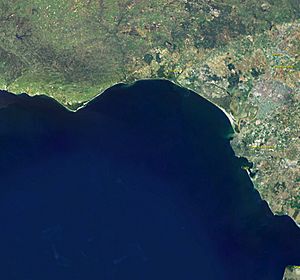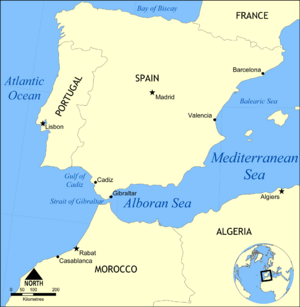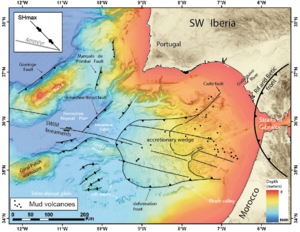Gulf of Cádiz facts for kids
Quick facts for kids Gulf of Cádiz |
|
|---|---|
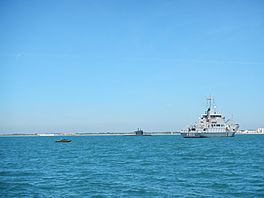 |
|
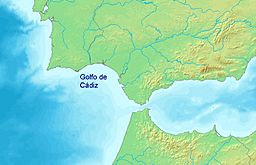
Map showing the Gulf of Cádiz.
|
|
| Location | Atlantic Ocean |
| Coordinates | 36°50′N 7°10′W / 36.833°N 7.167°W |
| Basin countries | Spain |
| Average depth | 200 to 4,000 m (660 to 13,120 ft) |
The Gulf of Cádiz (Spanish: Golfo de Cádiz, Portuguese: Golfo de Cádis) is a part of the Atlantic Ocean. It lies between the southern coast of Portugal and the western tip of the Strait of Gibraltar in Spain. Several important rivers flow into the gulf, including the Guadalquivir and the Guadiana. Smaller rivers like the Odiel, the Tinto, and the Guadalete also meet the ocean here.
The Gulf of Cádiz is found in the northeastern Atlantic Ocean. It is located between 34°N and 37°15′N latitude and 6°W to 9°45′W longitude. The gulf is surrounded by the southern coast of the Iberian Peninsula and the northern coast of Morocco. It is just west of the Strait of Gibraltar.
Contents
How the Gulf of Cádiz Formed
The way the Gulf of Cádiz was formed is closely linked to how plate tectonics work. This involves the movement of huge pieces of the Earth's crust. Here, the Southern Eurasian plate and the North African plate interact. Two main things cause this interaction:
Moving Earth Plates
One major process is called subduction. This is when one Earth plate slides under another. In this area, the Gibraltar Arc is moving westward, creating a special area called an accretionary wedge. This wedge is like a pile of scraped-off material. Scientists are still studying if this subduction is still happening actively. Some think it is, while others believe it has stopped. They suggest a new plate boundary might have formed. This new boundary acts like a giant sliding fault.
Plates Colliding Slowly
Another process is the slow collision of the Iberian Peninsula (part of Eurasia) and Nubia (part of Africa). These two plates are moving towards each other at about 4 millimeters (0.16 inches) per year. This movement is in a northwest-southeast direction. Some scientists believe this slow collision also causes active pushing and folding of the Earth's crust in the Gulf of Cádiz.
Mud Volcanoes and Deep-Sea Life
Scientists now know that the entire Gulf of Cádiz area is under pressure from these moving plates. This pressure leads to the formation of mud volcanoes. These are like small volcanoes that erupt mud and fluids instead of lava. They also release fluids rich in hydrocarbons, which are natural gases and oils. These fluids support many unique communities of life called chemosynthetic assemblages. These communities get their energy from chemicals, not sunlight.
The accretionary wedge, formed by the subduction process, is a huge area. It has over forty mud volcanoes. These mud volcanoes are found at depths ranging from 200 to 4,000 meters (656 to 13,123 feet). Scientists have confirmed their presence by taking core samples from the seafloor. Active methane gas leaks have also been found in several places.
Amazing Ocean Life
The first reports of special life forms living around the mud volcanoes in the Gulf of Cádiz came out in 2003. These creatures are called chemosymbiotic biota. This means they live in a partnership with tiny organisms that use chemicals for energy.
Types of Creatures Found
Scientists mainly found special worms called pogonophoran worms. But they also discovered many other animals. These included gastropods (like snails) and bivalves (like clams). There were also polychaete worms, crustaceans (like crabs), and echinoderms (like starfish). Even dead corals from the Madrepora and Lophelia groups were recorded.
Unique Bivalves
In 2011, scientists looked closely at the chemosymbiotic bivalves found on the mud volcanoes. They reported many different species. Some of these included Acharax gadirae, Solemya elarraichensis, and Bathymodiolus mauritanicus. Other species were Lucinoma asapheus, Thyasira vulcolutre, and Isorropodon perplexum. Many of these bivalve species are endemic. This means they are found only in this specific area and nowhere else in the world.
See also
 In Spanish: Golfo de Cádiz para niños
In Spanish: Golfo de Cádiz para niños
- Bay of Cádiz
- Guadalquivir Marshes
Images for kids


